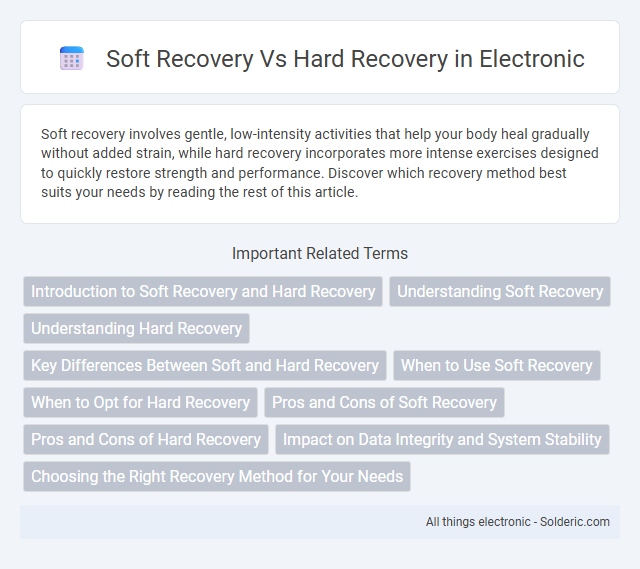Soft recovery involves gentle, low-intensity activities that help your body heal gradually without added strain, while hard recovery incorporates more intense exercises designed to quickly restore strength and performance. Discover which recovery method best suits your needs by reading the rest of this article.
Comparison Table
| Aspect | Soft Recovery | Hard Recovery |
|---|---|---|
| Definition | Restores the database by applying committed transactions since last checkpoint. | Restores the database by reapplying all transactions from the last backup, including uncommitted ones. |
| Scenario | Database crash or unexpected shutdown. | Database corruption or failure requiring full restore. |
| Data Loss | Minimal or none. Only uncommitted transactions lost. | Potentially higher, depending on the backup and logs. |
| Recovery Time | Faster due to fewer transaction applications. | Longer due to full data restoration and log replay. |
| Transaction Logs Usage | Uses transaction logs since last checkpoint. | Uses all transaction logs from last full backup. |
| Complexity | Less complex, automated by DBMS. | More complex, may require manual intervention. |
Introduction to Soft Recovery and Hard Recovery
Soft recovery involves restoring data and systems from backups without fully wiping existing configurations, minimizing downtime and preserving system settings. Hard recovery requires a complete system wipe and reinstallation from scratch, emphasizing total data restoration but with longer downtime and potential configuration loss. Selecting between soft and hard recovery depends on the severity of data corruption and the desired balance between speed and thoroughness.
Understanding Soft Recovery
Soft recovery refers to a data restoration process that prioritizes preserving maximum data integrity without performing aggressive repairs on corrupted files or storage devices. Unlike hard recovery, which can overwrite existing data during deep scans and repairs, soft recovery uses non-destructive techniques to safely recover accessible information. Understanding soft recovery helps you choose a method that minimizes risks and retains original data quality in cases of minor file corruption or accidental deletion.
Understanding Hard Recovery
Hard recovery focuses on restoring data from severely damaged storage devices where software-based tools fail to recover files due to physical damage or corruption. This process typically involves specialized hardware, cleanroom environments, and advanced techniques like chip-off or platter transplant to access and extract data directly from the damaged media. It is essential for scenarios involving physical disk failures, firmware corruption, or extensive logical damage that soft recovery methods cannot resolve.
Key Differences Between Soft and Hard Recovery
Soft recovery involves restoring data with minimal system changes, focusing on preserving existing configurations and user settings, ideal for less severe data loss. Hard recovery performs extensive repairs, often requiring complete system reinstallation or hardware fixes, targeting severe corruption or failure. Understanding these key differences helps you choose the appropriate recovery method for optimal data and system integrity restoration.
When to Use Soft Recovery
Soft recovery is best used when minimizing data loss and maintaining system integrity during unexpected shutdowns or crashes, as it partially rolls back uncommitted transactions while preserving committed data. It suits scenarios where your primary goal is quick restoration without affecting stable data, such as during minor system failures or power interruptions. This method ensures a faster database restart and reduces downtime compared to hard recovery, which involves a full rollback and can be more time-consuming.
When to Opt for Hard Recovery
Hard recovery is essential when your system experiences severe data corruption, hardware failure, or ransomware attacks that soft recovery methods cannot resolve. It provides a deeper, more comprehensive approach to restoring data by rebuilding corrupted files and repairing disk structures. You should opt for hard recovery when quick fixes fail, ensuring maximum data retrieval in critical failure scenarios.
Pros and Cons of Soft Recovery
Soft recovery offers the advantage of preserving more data integrity by gradually restoring system functions, minimizing the risk of data corruption compared to hard recovery methods. It allows for easier identification and correction of minor errors without the need for full system reboots, reducing downtime and operational disruptions. However, soft recovery can be slower and less effective in cases of severe system failures, requiring careful monitoring to ensure complete restoration of your data.
Pros and Cons of Hard Recovery
Hard recovery offers a fast and complete restoration of systems after failure, ensuring minimal downtime and preserving data integrity in critical environments. However, it can be resource-intensive, requiring significant system overhead and potentially leading to longer initial setup times. Your choice of hard recovery should align with the need for reliability and performance despite higher complexity and cost.
Impact on Data Integrity and System Stability
Soft recovery minimizes the risk of data loss by restoring system consistency through transaction rollbacks, preserving data integrity without requiring a full system restart. Hard recovery performs more intensive crash recovery including database recovery from system logs, which can ensure a thorough restoration but may increase downtime and affect system stability during processing. Your choice between soft and hard recovery influences the balance between maintaining continuous system availability and ensuring comprehensive data integrity restoration.
Choosing the Right Recovery Method for Your Needs
Soft recovery involves restoring data with minimal system alteration, ideal for minor file loss or corruption, preserving existing configurations and preventing further damage. Hard recovery requires more intensive methods such as disk imaging or hardware repair, suited for severe data loss scenarios like physical damage or complex corruption. Selecting the right recovery method depends on the extent of data damage, system stability, and the urgency of restored access.
Soft recovery vs Hard recovery Infographic

 solderic.com
solderic.com